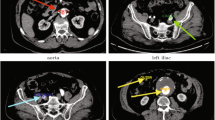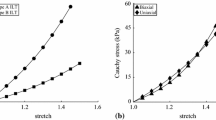Abstract
While hemodynamic forces and intraluminal thrombus (ILT) are believed to play important roles on abdominal aortic aneurysm (AAA), it has been suggested that hemodynamic forces and ILT also interact with each other, making it a complex problem. There is, however, a pressing need to understand relationships among three factors: hemodynamics, ILT accumulation, and AAA expansion for AAA prognosis. Hence this study used longitudinal computer tomography scans from 14 patients and analyzed the relationship between them. Hemodynamic forces, represented by wall shear stress (WSS), were obtained from computational fluid dynamics; ILT accumulation was described by ILT thickness distribution changes between consecutives scans, and ILT accumulation and AAA expansion rates were estimated from changes in ILT and AAA volume. Results showed that, while low WSS was observed at regions where ILT accumulated, the rate at which ILT accumulated occurred at the same rate as the aneurysm expansion. Comparison between AAAs with and without thrombus showed that aneurysm with ILT recorded lower values of WSS and higher values of AAA expansion than those without thrombus. Findings suggest that low WSS may promote ILT accumulation and submit the idea that by increasing WSS levels ILT accumulation may be prevented.










Similar content being viewed by others
References
Arzani, A., G.-Y. Suh, R. L. Dalman, and S. C. Shadden. A longitudinal comparison of hemodynamics and intraluminal thrombus deposition in abdominal aortic aneurysms. Am. J. Physiol.—Heart Circ. Physiol. 2014. doi:10.1152/ajpheart.00461.2014.
Basciano, C., C. Kleinstreuer, S. Hyun, and E. A. Finol. A relation between near-wall particle-hemodynamics and onset of thrombus formation in abdominal aortic aneurysms. Ann. Biomed. Eng. 39:2010–2026, 2011.
Biasetti, J., T. C. Gasser, M. Auer, U. Hedin, and F. Labruto. Hemodynamics of the normal aorta compared to fusiform and saccular abdominal aortic aneurysms with emphasis on a potential thrombus formation mechanism. Ann. Biomed. Eng. 38:380–390, 2009.
Bluestein, D., K. Dumont, M. De Beule, J. Ricotta, P. Impellizzeri, B. Verhegghe, and P. Verdonck. Intraluminal thrombus and risk of rupture in patient specific abdominal aortic aneurysm—FSI modelling. Comput. Methods Biomech. Biomed. Engin. 12:73–81, 2009.
Boussel, L., V. Rayz, C. McCulloch, A. Martin, G. Acevedo-Bolton, M. Lawton, R. Higashida, W. S. Smith, W. L. Young, and D. Saloner. Aneurysm growth occurs at region of low wall shear stress: patient-specific correlation of hemodynamics and growth in a longitudinal study. Stroke 39:2997, 2008.
Brady, A. R., S. G. Thompson, F. G. Fowkes, R. M. Greenhalgh, and J. T. Powell. Abdominal aortic aneurysm expansion risk factors and time intervals for surveillance. Circulation 110:16–21, 2004.
Chatzizisis, Y. S., A. U. Coskun, M. Jonas, E. R. Edelman, C. L. Feldman, and P. H. Stone. Role of endothelial shear stress in the natural history of coronary atherosclerosis and vascular remodeling. J. Am. Coll. Cardiol. 49:2379–2393, 2007.
Dalman, R. L. Oxidative stress and abdominal aneurysms: how aortic hemodynamic conditions may influence AAA disease. Cardiovasc. Surg. Lond. Engl. 11:417–419, 2003.
Di Achille, P., G. Tellides, C. A. Figueroa, and J. D. Humphrey. A haemodynamic predictor of intraluminal thrombus formation in abdominal aortic aneurysms. Proc. R. Soc. Lond. Math. Phys. Eng. Sci. 470:20140163, 2014.
Di Martino, E. S., A. Bohra, J. P. Vande Geest, N. Gupta, M. S. Makaroun, and D. A. Vorp. Biomechanical properties of ruptured versus electively repaired abdominal aortic aneurysm wall tissue. J. Vasc. Surg. 43:570–576, 2006.
Di Martino, E. S., S. Mantero, F. Inzoli, G. Melissano, D. Astore, R. Chiesa, and R. Fumero. Biomechanics of abdominal aortic aneurysm in the presence of endoluminal thrombus: experimental characterisation and structural static computational analysis. Eur. J. Vasc. Endovasc. Surg. 15:290–299, 1998.
Doyle, B. J., T. M. McGloughlin, E. G. Kavanagh, and P. R. Hoskins. From detection to rupture: a serial computational fluid dynamics case study of a rapidly expanding, patient-specific, ruptured abdominal aortic aneurysm. In: Computational Biomechanics for Medicine, edited by B. Doyle, K. Miller, A. Wittek, and P. M. F. Nielsen. New York: Springer, 2014, pp. 53–68.
Dua, M. M., and R. L. Dalman. Hemodynamic influences on abdominal aortic aneurysm disease: application of biomechanics to aneurysm pathophysiology. Vascul. Pharmacol. 53:11–21, 2010.
Farsad, M., B. Zambrano, and S. Baek. Association of intraluminal thrombus, hemodynamic forces, and abdominal aortic aneurysm expansion using longitudinal CT images. In: Computational Biomechanics for Medicine. Berlin: Springer, 2015, pp. 13–23.
Finol, E. A., and C. H. Amon. Flow-induced wall shear stress in abdominal aortic aneurysms: part I-steady flow hemodynamics. Comput. Methods Biomech. Biomed. Eng. 5:309–318, 2002.
Finol, E. A., and C. H. Amon. Flow-induced wall shear stress in abdominal aortic aneurysms: part II-pulsatile flow hemodynamics. Comput. Methods Biomech. Biomed. Eng. 5:319–328, 2002.
Folkesson, M., A. Silveira, P. Eriksson, and J. Swedenborg. Protease activity in the multi-layered intra-luminal thrombus of abdominal aortic aneurysms. Atherosclerosis 218:294–299, 2011.
Gaillard, E., P. Bergeron, and V. Deplano. Influence of wall compliance on hemodynamics in models of abdominal aortic aneurysm. J. Endovasc. Ther. 14:593–599, 2007.
Georgakarakos, E., C. V. Ioannou, S. Volanis, Y. Papaharilaou, J. Ekaterinaris, and A. N. Katsamouris. The influence of intraluminal thrombus on abdominal aortic aneurysm wall stress. Int. Angiol. 28:325–333, 2009.
Gharahi, H., B. A. Zambrano, C. Lim, J. Choi, W. Lee, and S. Baek. On growth measurements of abdominal aortic aneurysms using maximally inscribed sphere. Med. Eng. Phys. 37:683–691, 2015.
Gijsen, F. J. H., F. N. van de Vosse, and J. D. Janssen. Wall shear stress in backward-facing step flow of a red blood cell suspension. Biorheology 35:263–279, 1998.
Gijsen, F. J., F. N. van de Vosse, and J. D. Janssen. The influence of the non-Newtonian properties of blood on the flow in large arteries: steady flow in a carotid bifurcation model. J. Biomech. 32:601–608, 1999.
Gimbrone, M. A., K. R. Anderson, J. N. Topper, et al. Special communication: the critical role of mechanical forces in blood vessel development, physiology and pathology. J. Vasc. Surg. 29:1104–1151, 1999.
Hans, S. S., O. Jareunpoon, M. Balasubramaniam, and G. B. Zelenock. Size and location of thrombus in intact and ruptured abdominal aortic aneurysms. J. Vasc. Surg. 41:584–588, 2005.
Hansen, K. B., A. Arzani, and S. C. Shadden. Mechanical platelet activation potential in abdominal aortic aneurysms. J. Biomech. Eng. 137:041005–041005, 2015.
Harter, L. P., B. H. Gross, P. W. Callen, and R. A. Barth. Ultrasonic evaluation of abdominal aortic thrombus. J. Ultrasound Med. 1:315–318, 1982.
Humphrey, J. D. Vascular adaptation and mechanical homeostasis at tissue, cellular, and sub-cellular levels. Cell Biochem. Biophys. 50:53–78, 2008.
Kazi, M., J. Thyberg, P. Religa, J. Roy, P. Eriksson, U. Hedin, and J. Swedenborg. Influence of intraluminal thrombus on structural and cellular composition of abdominal aortic aneurysm wall. J. Vasc. Surg. 38:1283–1292, 2003.
Les, A. S., S. C. Shadden, C. A. Figueroa, J. M. Park, M. M. Tedesco, R. J. Herfkens, R. L. Dalman, and C. A. Taylor. Quantification of hemodynamics in abdominal aortic aneurysms during rest and exercise using magnetic resonance imaging and computational fluid dynamics. Ann. Biomed. Eng. 38:1288–1313, 2010.
Li, Z.-Y., J. U-King-Im, T. Y. Tang, E. Soh, T. C. See, and J. H. Gillard. Impact of calcification and intraluminal thrombus on the computed wall stresses of abdominal aortic aneurysm. J. Vasc. Surg. 47:928–935, 2008.
Malek, A. M., S. L. Alper, and S. Izumo. Hemodynamic shear stress and its role in atherosclerosis. JAMA 282:2035–2042, 1999.
Mower, W. R., W. J. Quiñones, and S. S. Gambhir. Effect of intraluminal thrombus on abdominal aortic aneurysm wall stress. J. Vasc. Surg. 26:602–608, 1997.
Nakahashi, T. K., K. Hoshina, P. S. Tsao, E. Sho, M. Sho, J. K. Karwowski, C. Yeh, R.-B. Yang, J. N. Topper, and R. L. Dalman. Flow loading induces macrophage antioxidative gene expression in experimental aneurysms. Arterioscler. Thromb. Vasc. Biol. 22:2017–2022, 2002.
Olufsen, M. S., C. S. Peskin, W. Y. Kim, E. M. Pedersen, A. Nadim, and J. Larsen. Numerical simulation and experimental validation of blood flow in arteries with structured-tree outflow conditions. Ann. Biomed. Eng. 28:1281–1299, 2000.
Raghavan, M. L., J. Kratzberg, E. M. Castro de Tolosa, M. M. Hanaoka, P. Walker, and E. S. da Silva. Regional distribution of wall thickness and failure properties of human abdominal aortic aneurysm. J. Biomech. 39:3010–3016, 2006.
Raghavan, M. L., D. A. Vorp, M. P. Federle, M. S. Makaroun, and M. W. Webster. Wall stress distribution on three-dimensionally reconstructed models of human abdominal aortic aneurysm. J. Vasc. Surg. 31:760–769, 2000.
Salsac, A. V., S. R. Sparks, J. M. Chomaz, and J. C. Lasheras. Evolution of the wall shear stresses during the progressive enlargement of symmetric abdominal aortic aneurysms. J. Fluid Mech. 560:19–51, 2006.
Schurink, G. W., J. M. van Baalen, M. J. Visser, and J. H. van Bockel. Thrombus within an aortic aneurysm does not reduce pressure on the aneurysmal wall. J. Vasc. Surg. 31:501–506, 2000.
Sheidaei, A., S. C. Hunley, S. Zeinali-Davarani, L. G. Raguin, and S. Baek. Simulation of abdominal aortic aneurysm growth with updating hemodynamic loads using a realistic geometry. Med. Eng. Phys. 33:80–88, 2011.
Shindo, S., H. Matsumoto, K. Kubota, A. Kojima, M. Matsumoto, K. Satoh, and Y. Ozaki. Is the size of an abdominal aortic aneurysm associated with coagulopathy? World J. Surg. 29:925–929, 2005.
Shum, J., E. S. DiMartino, A. Goldhamme, D. H. Goldman, L. C. Acker, G. Patel, J. H. Ng, G. Martufi, and E. A. Finol. Semiautomatic vessel wall detection and quantification of wall thickness in computed tomography images of human abdominal aortic aneurysms. Med. Phys. 37:638–648, 2010.
Silver, A. E., and J. A. Vita. Shear stress-mediated arterial remodeling in atherosclerosis too much of a good thing? Circulation 113:2787–2789, 2006.
Swedenborg, J., and P. Eriksson. The intraluminal thrombus as a source of proteolytic activity. Ann. N. Y. Acad. Sci. 1085:133–138, 2006.
Taylor, C. A., T. J. R. Hughes, and C. K. Zarins. Effect of exercise on hemodynamic conditions in the abdominal aorta. J. Vasc. Surg. 29:1077–1089, 1999.
Thubrikar, M. J., M. Labrosse, F. Robicsek, J. Al-Soudi, and B. Fowler. Mechanical properties of abdominal aortic aneurysm wall. J. Med. Eng. Technol. 25:133–142, 2001.
Thubrikar, M. J., F. Robicsek, M. Labrosse, V. Chervenkoff, and B. L. Fowler. Effect of thrombus on abdominal aortic aneurysm wall dilation and stress. J. Cardiovasc. Surg. (Torino) 44:67–77, 2003.
Vardulaki, K. A., T. C. Prevost, N. M. Walker, N. E. Day, A. B. Wilmink, C. R. Quick, H. A. Ashton, and R. A. Scott. Growth rates and risk of rupture of abdominal aortic aneurysms. Br. J. Surg. 85:1674–1680, 1998.
Vorp, D. A., W. J. Federspiel, and M. W. Webster. Does laminated intraluminal thrombus within abdominal aortic aneurysm cause anoxia of the aortic wall? J. Vasc. Surg. 23:540–541, 1996.
Vorp, D. A., P. C. Lee, D. H. Wang, M. S. Makaroun, E. M. Nemoto, S. Ogawa, and M. W. Webster. Association of intraluminal thrombus in abdominal aortic aneurysm with local hypoxia and wall weakening. J. Vasc. Surg. 34:291–299, 2001.
Wang, D. H., M. S. Makaroun, M. W. Webster, and D. A. Vorp. Effect of intraluminal thrombus on wall stress in patient-specific models of abdominal aortic aneurysm. J. Vasc. Surg. 36:598–604, 2002.
Wilson, J. S., L. Virag, P. Di Achille, I. Karsaj, and J. D. Humphrey. Biochemomechanics of intraluminal thrombus in abdominal aortic aneurysms. J. Biomech. Eng. 135:021011, 2013.
Wood, N. B. Aspects of fluid dynamics applied to the larger arteries. J. Theor. Biol. 199:137–161, 1999.
Yu, S. C. M. Steady and pulsatile flow studies in abdominal aortic aneurysm models using particle image velocimetry. Int. J. Heat Fluid Flow 21:74–83, 2000.
Acknowledgments
The authors gratefully acknowledge the support, in part, by the National Heart, Lung, and Blood Institute of the National Institutes of Health (R01HL115185 and R21HL113857) and National Science Foundation (CMMI-1150376). The contents are solely the responsibility of the authors and do not necessarily represent the official views of the NIH and NSF.
Author information
Authors and Affiliations
Corresponding author
Additional information
Associate Editor Ender Finol oversaw the review of this article.
Rights and permissions
About this article
Cite this article
Zambrano, B.A., Gharahi, H., Lim, C. et al. Association of Intraluminal Thrombus, Hemodynamic Forces, and Abdominal Aortic Aneurysm Expansion Using Longitudinal CT Images. Ann Biomed Eng 44, 1502–1514 (2016). https://doi.org/10.1007/s10439-015-1461-x
Received:
Accepted:
Published:
Issue Date:
DOI: https://doi.org/10.1007/s10439-015-1461-x




